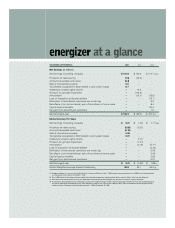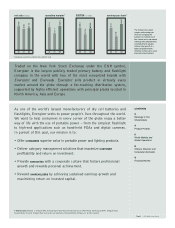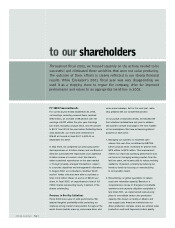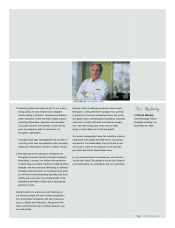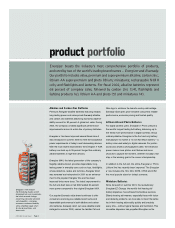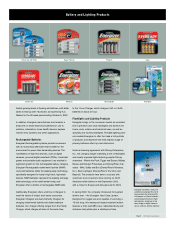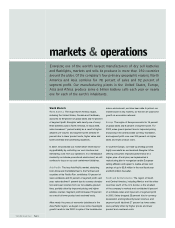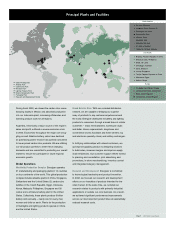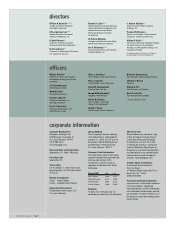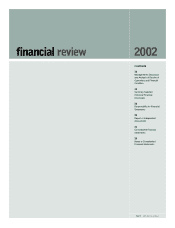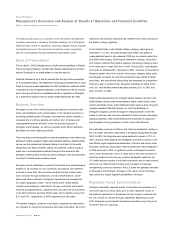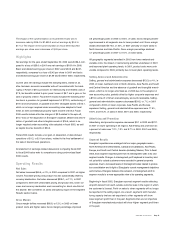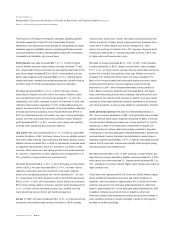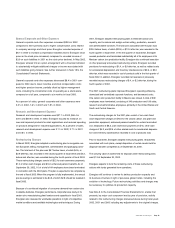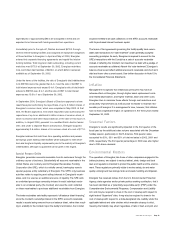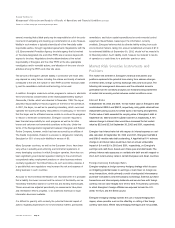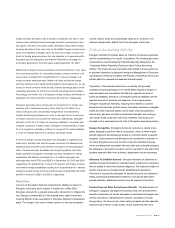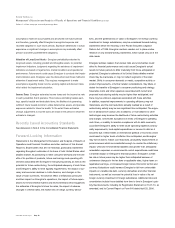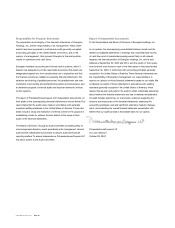Energizer 2002 Annual Report Download - page 12
Download and view the complete annual report
Please find page 12 of the 2002 Energizer annual report below. You can navigate through the pages in the report by either clicking on the pages listed below, or by using the keyword search tool below to find specific information within the annual report.
The following discussion is a summary of the key factors management
considers necessary in reviewing Energizer Holdings, Inc.’s (Energizer)
historical basis results of operations, operating segment results, liquidity
and capital resources. This discussion should be read in conjunction
with the Consolidated Financial Statements and related notes.
Basis of Presentation
Prior to April 1, 2000, Energizer was a wholly owned subsidiary of Ralston
Purina Company (Ralston). On that date, Ralston distributed the common
stock of Energizer to its shareholders in a tax-free spin-off.
Financial statements as of and for periods after the spin-off are presented
on a consolidated basis. The Statement of Earnings and Statement of Cash
Flows for the year ended September 30, 2000 include the combined results
of operations of the Energizer businesses under Ralston for the six months
prior to the spin-off and the consolidated results of operations of Energizer
on a stand-alone basis for the six months ended September 30, 2000.
Business Overview
Energizer is one of the world’s largest manufacturers of primary bat-
teries and flashlights and a global leader in the dynamic business of
providing portable power. Energizer manufactures and/or markets a
complete line of primary alkaline and carbon zinc, miniature and
rechargeable batteries primarily under the brands Energizer e2,
Energizer and Eveready, as well as specialty photo lithium batteries,
flashlights and other lighting products.
There has been a continuing shift in consumer preference from carbon zinc
batteries to higher powered, higher priced alkaline batteries. Alkaline batter-
ies are now the predominant primary battery in most parts of the world
except Asia and Africa. However, carbon zinc batteries continue to play a
major role in less developed countries throughout the world and offer
Energizer market position in those countries. Energizer uses its full portfolio
of products to better meet consumer needs.
Energizer and its subsidiaries operate 21 manufacturing and packaging
facilities in 14 countries on four continents. Its products are marketed
and sold in more than 150 countries primarily through a direct sales
force, and also through distributors, to mass merchandisers, whole-
salers and other customers. Energizer’s operations are managed via
four major geographic areas – North America (the United States,
Canada and Caribbean), Asia Pacific, Europe, and South and Central
America (including Mexico). Segment profit and sales are concentrated
in the North America and Asia Pacific areas which together account for
92% and 78%, respectively, of 2002 segment profit and sales.
The battery category continues to be highly competitive as manufactur-
ers compete for consumer acceptance and retail shelf space. Economic
weakness and inventory reductions by retailers have further pressured
the battery category globally.
In the United States, retail alkaline battery category sales grew an
estimated 7% to 10% annually through fiscal 1999, and spiked to
unprecedented levels in late calendar 1999 due to concerns about the
year 2000 date change. Following the millennium change, consumers
and retailers reduced their battery supplies, dampening category sales
in the latter part of fiscal 2000 and in 2001. During 2002, retail alkaline
units grew an estimated 6% compared to 2001, but have not returned to
historical growth rates. Over the last three years, category dollar sales
have lagged unit sales as consumer purchases have shifted to larger
pack sizes, and promotional discounting has deepened as competitors
attempt to gain or protect share. Energizer estimates its share of the
total U.S. retail alkaline market was approximately 32% in 2002 and
2001 and 33% in 2000.
Retail outlets experiencing the strongest battery category growth in the
United States include mass merchandisers’ super center format, home
centers and dollar stores, while traditional outlets such as food, drug and
hardware declined. Wal-Mart Stores, Inc. and its subsidiaries is
Energizer’s largest customer. Energizer is well positioned to meet the
needs of customer and consumer demands in these formats, leveraging
category expertise, retail understanding and its portfolio of products to
give Energizer a strong presence in each of the retail channels.
Internationally, economic conditions and currency devaluation, relative to
the U.S. dollar, have been unfavorable to Energizer during 2000 through
2002. In 2002, the Argentine peso value declined in excess of 70%. In
2001, Australia, New Zealand, the Philippines and other countries in the
Asia Pacific region experienced devaluation. The Euro and certain other
European currencies rebounded in 2002 and late 2001 after devaluation
in 2000 and most of 2001. A significant portion of Energizer’s product
cost is more closely tied to the U.S. dollar than to the local currencies in
which the product is sold. As such, currency devaluation relative to the
U.S. dollar reduces margins to the extent increased costs in local currency
terms are not offset by local currency price increases. Conversely,
strengthening currencies relative to the U.S. dollar are generally favorable
to Energizer’s profit margins. Changes in the value of local currencies
may continue to impact segment profitability in the future.
Reporting Period Synchronization
Energizer historically reported results of international operations on a
one-month lag. As a result, years prior to 2001 represent results of
international operations for September through August combined with
the U.S. results for October through September. Beginning in fiscal
2001, Energizer synchronized international operations’ reporting to be
consistent with U.S. reporting.
Energizer Holdings, Inc.
Management’s Discussion and Analysis of Results of Operations and Financial Condition
(Dollars in millions except per share and percentage data)
ENR 2002 Annual Report Page 10


